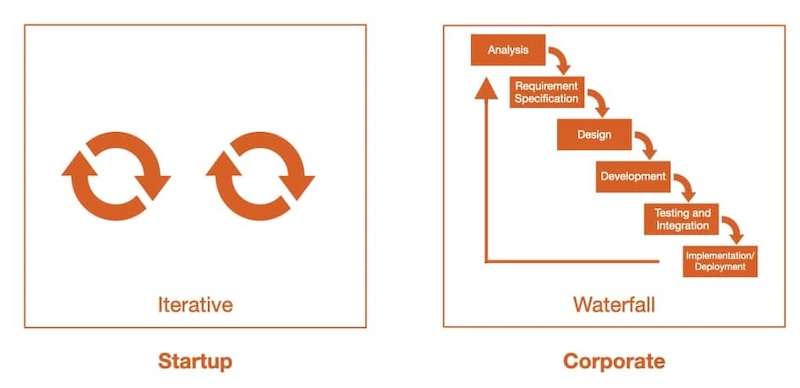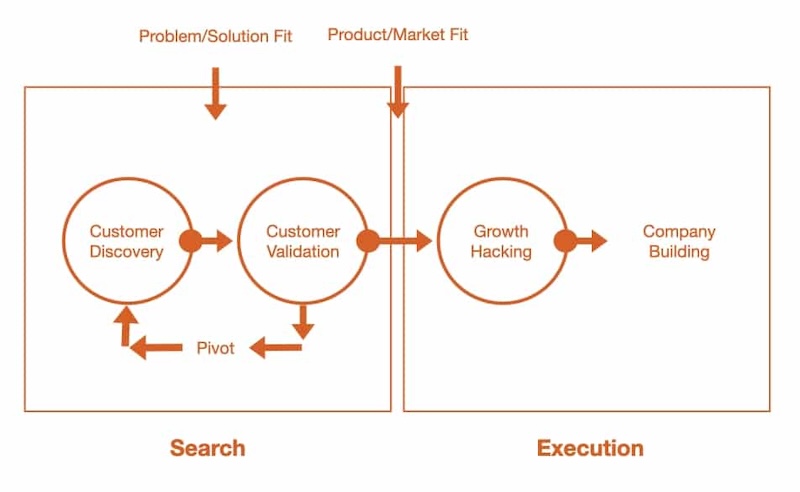Customer development is one of the essential pillars for the lean start-up methodology receiving massive traction after the book by Eric Ries was published. It is described as the intermediate step of the process, preceded by designing the business model and followed by agile engineering with the clear goal of understanding the customers and the problem you are trying to solve.
The reason for customer development
This approach applies to start-ups and giant corporations such as Dropbox, Zappos, or General Electric, aiming to shorten product development cycles and discover if a business model is viable.
Surely you have heard that the main reason why startups fail is they are building something nobody wants. Here is a list of the top 10 reasons for failure based on research from 100 first hits.
- 36%: Building something nobody wants
- 18%: Hiring poorly
- 13%: Lack of focus
- 12%: Fail to execute sales and marketing
- 7,9%: Not having the right co-founders
- 5,4%: Chasing investors, not customers
- 3,3%: Not making sure you have enough money
- 2,1%: Spending too much money
- 1,4%: Failing to ask for help
- 0,7%: Ignoring Social Media
A problem mindset is vital
36% of startups fail because founders focus on a solution mindset rather than a problem mindset. Also, Donald Miller, author of the book “Building a story brand” describes the key to building a successful brand as starting with the villain when telling a story. The villain creates the problem, and you should on the problem in the beginning rather than introducing the solution. The center is always the customer and their pain.
However, many startups focus purely on their solution and their technology. To succeed, there needs to be a shift toward a problem mindset and put the customer at the center of the endeavor. And this is where customer development plays such an essential role. Based on research done by McKinsey, only 17% of product introductions are successful because most companies follow a traditional product development process.

And the truth is, in most cases, following this system will lead to failure in such a massive way that it causes trauma and huge irreversible problems.
Introduction of the dual-core concept
The ideology of customer development counters this vicious cycle, created by the godfather of Lean Startup, Steve Blank, and demonstrates innovation development as two separate cores.

The execution engine is the waterfall engine reflecting the big corporation you will become one day or already are with long development cycles and big budgets. However, when planning to innovate, you need to be part of a smaller and agile core called a search engine/exploration engine or startup engine. This engine has its own rules of engagement and metrics with the only goal of finding a repeatable and scalable business model.
Once you know that the solution solves a real problem and has a market, you enter the execution phase, knowing what needs to be done and for whom. While in the exploratory phase, looking for a product-market fit or problem-solution fit, you must embrace the fact of not knowing. Admitting that, provides freedom and room for experimentation and is the basis for proper customer development and business success.
The 4 steps of customer development
- Customer Discovery: The focus is lying on testing different hypotheses and understanding customer pains, problems and needs.
- Customer Validation: In this stage you introduce your solution and begin to develop replicable and scalable sales models.
- Growth Hacking/Customer Creation: You start creating and pushing end user demands to scale sales
- Company Building: You transition the organization from one created for learning, discovery and validation to a smooth running engine aiming for execution and longevity.

When we follow the concept of the dual-core innovation system, we see that customer discovery and validation is only part of the search phase with the goal of building your innovation in line with your customers.
Search Stage: Customer discovery and validation
While in search customer development is split again into two phases - customer discovery and validation. We first tackle problem-solution fit, discovering who is your customer and what is their problem and the solution remains irrelevant at this point. After realizing who the customers and their pains are you move into the customer validation stage where you test your hypothesis and introduce the solution to their problem. When you insert your product into the process, you can validate if it impacts the problem-solution fit you discovered initially and whether there is a product-market fit.
In summary, customer discovery is when you find problem-solution fit, whereas customer validation is where you find product-market fit. It is widespread that organizations directly go to customer validation without focusing on customer discovery first. Within the following list of goals for customer discovery, many choose number 5 as their first pick because they see it as an identification of the problem or going to the waterfall approach of number 2, running focus groups and lengthy research.
- Collecting all features that customers desire
- Creating focus groups to validate if you are right
- Learning what the customers’ problems are
- Handing product development a detailed marketing requirements plan
- Selling your product to customers
However, it should be
number 3: Learning what the customers’ problem is rather than what the customer wants or what he is willing to pay but what is paining them now. Identifying prospects with the most significant pain are those who will first use your solution and are eager to test it even though it is not flawless. This customer group will be engaged with your product and provide the insights required to optimize your solution.
This entire approach can be summarized in one sentence:
“Fall in love with the problem, not the solution!”
Execution Stage: Growth Hacking and company building
The execution stage can be described as the transition from a start-up to a real business because you validated your solution and begin the initiation into the market. You start to market the solution, test different channels and sales strategies and potentially fine tune the solution based on additional insights gathered. You will continue to carefully listen to customers and investigate how the market is behaving after the solution is introduced. Your goal is to guarantee a sustainable business with growing demand and less to explore at this point.
Once you proved that the business can handle growth and captured all the learning and insights you move over to the company building stage. You will begin structuring departments, enhance the product, execute marketing and sales plans, and scale the solution. Also in this phase most economic resources are consumed because you need to invest heavily in creating the fundament for strong growth.
Maybe a final remark for applying this approach to large corporations. Some of you might have worked for or with large companies and you surely know the pain of silo thinking and lack of flexibility and speed. This is why the market sees a massive growth in so called innovation groups or frontrunners within organizations. These teams are often detached from departments with own budgets and lean structures to allow corporations to bring back speed into their business. These teams usually operate only in the Search Engine, testing new technologies like AI or work with Startup accelerators to create proof of concepts within a few months. Their goal is discovering and validating new business opportunities as well as areas for improvement.
Dynamic persona creation for customer development
The World is constantly changing, especially over the past years. We all are not the same as we were five years ago. Our perspectives change, our desires and needs change, and we evolve in different ways, and products and solutions need to evolve together with us. Many articles emphasize that personas must be dynamic and change along your business journey. Creating personas once any try to market to them for ten years, in the same way, will lead to failure. Your product and customer communication must pivot to stay relevant for the market. Check this article, if you want to learn more about
dynamic personas. Therefore, it is fundamental to continuously keep customer development in the search engine to question your business model.
The core of personas should be the needs and pain points they currently face rather than demographics. Ideally, the personas also reflect the customer cluster size to identify the group with the most significant pain. This is the user group you want to focus on initially because they are eager to work with you to find a solution for their problem. Many argue that it is incredibly challenging to build these personas before you have actual customers simply because of the lack of internal data. However, with the fast digitalization gathering external data through social listening or running small ad campaigns even without having an actual product is straightforward. Once you identify this group, you can take customer discovery further and enrich the personas with insights from customer interviews or surveys. It will enable you to validate whether your solution is the right fit for them, whether it needs pivoting, and if there is an addressable size market, irrespective of being a startup or a corporation planning to launch a new product.
Also dynamic personas are a critical tool to transition your company from the search stage to the execution stage. Irrespective of being a startup or an innovation team, personas will help to deliver the insights to those who need to execute them. Product development will know which features are required, whereas marketing and sales receive a clear overview of of the customer segments, their needs and pains as well as the right strategy to market to them.
Check out the article on
creating a perfect persona for product development or reach out to us to help you with this endeavor.
Frequently Asked Questions
1. How long does each stage of customer development typically take, and are there any common challenges or roadblocks that can extend the timeline?
The duration of each stage in customer development can vary widely depending on the complexity of the product or service, the target market, and other factors. However, each stage typically takes several weeks to several months to complete. Common challenges that can extend the timeline include difficulties in identifying and reaching the target customer segment, gathering and analyzing feedback effectively, and iterating on the product or service based on customer insights.
2. Are there specific strategies or best practices for effectively conducting customer interviews and gathering feedback during the customer development process?
To conduct effective customer interviews and gather feedback during the customer development process, it's important to start by clearly defining the goals of the interviews and the specific information you are trying to gather. It can be helpful to use open-ended questions to encourage detailed responses from customers and to actively listen to their feedback without imposing your own biases. Additionally, conducting interviews in a structured manner and keeping detailed notes can help ensure that you capture valuable insights.
3. Once a startup has completed the customer development process, what are the next steps for implementing the insights gained and moving towards product-market fit?
Once a startup has completed the customer development process, the next steps involve implementing the insights gained to refine the product or service and move towards product-market fit. This can include iterating on the product based on customer feedback, refining the target market and messaging based on customer insights, and developing a go-to-market strategy to effectively reach and acquire customers. It's also important to continue gathering feedback from customers and iterating on the product or service based on their needs and preferences.